Activity Level: Moderate
Hypoallergenic: Yes
Social Ability: Selectively Social
Skills: Companionship
Intelligence: Average
Ideal Climate: Temperate, Low Humidity
An adorable teacup-sized dog, the Maltese is a highly compassionate companion pet with distinctive long, white fur. Though their origins are mysterious, there is no mystery about why everyone loves a Maltese—with short faces and stubby legs, they’re just as cute as they are friendly.
Breed Overview
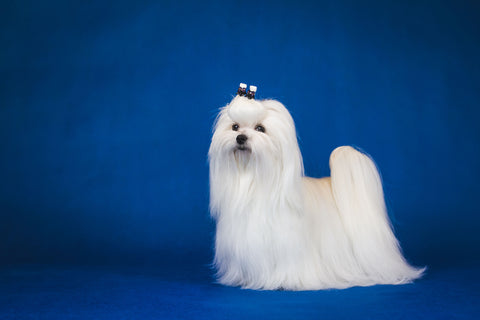 Origin: Though most canine breeds have long histories rooted in traditions sometimes centuries old, the Maltese, however, has a past shrouded in mystery. Dating back to 500 B.C.E., art pieces found in modern Italy have depicted small impish dogs with long straight fur, often captioned with a word translating to ‘melitaie.’ Troves of ancient Greek and Roman writings refer to a small canine from the island of Malta or the island of Mljet, either of which may be the source of the Maltese moniker.
Origin: Though most canine breeds have long histories rooted in traditions sometimes centuries old, the Maltese, however, has a past shrouded in mystery. Dating back to 500 B.C.E., art pieces found in modern Italy have depicted small impish dogs with long straight fur, often captioned with a word translating to ‘melitaie.’ Troves of ancient Greek and Roman writings refer to a small canine from the island of Malta or the island of Mljet, either of which may be the source of the Maltese moniker.
In the age of genealogical testing, we know that Maltese dogs are related to Havanese and Bichons. These canines were some of the first recorded companion canines, residing at the sides of Marie Antoinnette, Queen Victoria, and many others. In modern times, the word Maltese now refers both to the aforementioned ancient breed and the new-age toy breed.
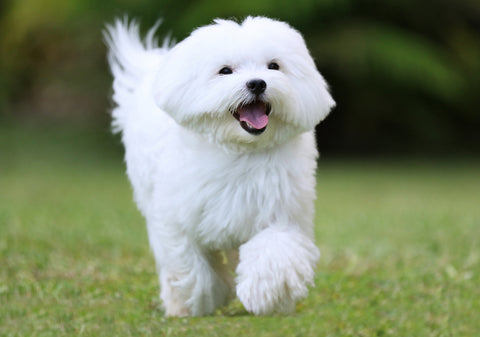
History: Canine experts generally agree to a somewhat on-the-fence statement; they claim that, though the Maltese has a long and mysterious history, these canines were not an official breed by genealogical standards before the Victorian era. The basis of these standards depends on the genetic traits and distinct features of generations of these canines, not necessarily taking into account intermittent, amateur, and cross-breed breeding practices of centuries past.
In the early days of the Maltese’s official history, it was deduced that their iconic stout-nosed face is the result of selective breeding of similar toy breeds. It was only after the breed standardization in the nineteenth century that the silky white coat became a requirement. Now, a typical Maltese dog is eye-catching and unique, living happy lives in homes and as companions all over the world.
Breed Attributes
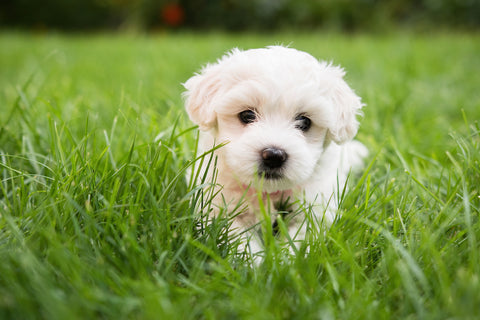 Temperament: The breed standard regarding the Maltese dog temperament calls the dog ‘affectionate’ and ‘lively,’ two endearing qualities that make the breed easy to love, although they can be high-maintenance. Their playful nature combined with high intelligence means that they do not tolerate alone time very well, unless they are specifically trained to be alone for long periods of time. Veterinary behaviorists often recommend crate training to help ease separation anxiety.
Temperament: The breed standard regarding the Maltese dog temperament calls the dog ‘affectionate’ and ‘lively,’ two endearing qualities that make the breed easy to love, although they can be high-maintenance. Their playful nature combined with high intelligence means that they do not tolerate alone time very well, unless they are specifically trained to be alone for long periods of time. Veterinary behaviorists often recommend crate training to help ease separation anxiety.
While every dog is unique, Malteses have been companions for centuries and their sweet nature has not gone unnoticed all those years. These dogs make fantastic family pets and are great with children, and they typically thrive in large families with plenty of animal and human to play with.
Personality: Every Maltese owner will tell you—these dogs live to play with you! Their high-energy temperament means they’re always ready to run and play. Canines of any breed may experience anxiety and exhibit destructive behavior if they are not able to expend this stored energy.
Ideal Owner: You! A Maltese is a little ball of energy, a tireless tail-wagger, and an incredibly loyal friend. Great for a small family or a part of a gaggle, a Maltie is a fantastic addition to any home.
Fur Care
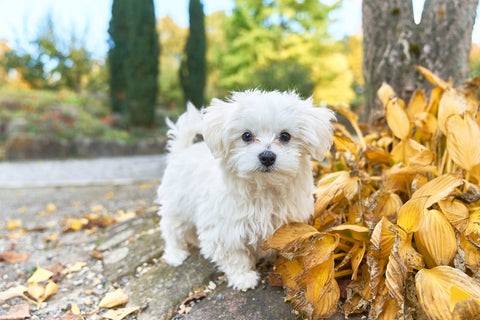
Grooming: A Maltese’s long white coat is unmistakable and absolutely beautiful. To maintain skin and coat health, these canines require daily brushing to prevent matting and tangling. Consistent groomer visits or at-home grooming is essential to keep their coat looking its brilliant best. A gentle whitening shampoo is a great idea to both keep them clean and enhance the shine of their coat.
Like all canine breeds, their nails should be trimmed as needed, and their ears should be cleaned or flushed regularly. Due to their shortened face, Malties may experience eye irritation or infections which must be evaluated by a veterinarian. These ocular issues may contribute to tear staining, a harmless discoloration of face fur that can be addressed with Maltese Tear Stain Wipes to help lift the eye stain and keep the skin healthy.
Shedding: A Maltese typically sheds less than the average dog, so this breed is considered hypoallergenic. Regular brushing is recommended to keep their skin and coat healthy as well as help distribute natural oils to the shaft and ends of the fur to maintain shine.
Colors: White
Health

Common Issues: Responsible breeders will test their stock before breeding, but canines of all breeds can be susceptible to medical conditions and illnesses. Maltese dog health issues are generally few and far between, but they are predisposed to a few conditions about which owners should be aware.
A joint condition called Luxating Patella and a cardiovascular condition called Patent Ductus Arteriosus (PDA) are common among Malteses, both of which can be diagnosed and managed by your veterinarian. Vets often recommend supplementation with compounds such as Glucosamine and Chondroitin for ongoing joint support; our Maltese Z-Flex Hip and Joint Support Chews contain high-potency ingredients that provide nutritional support to joint tissues, which helps maintain structure and function over time.
More serious liver health problems for Malteses may be caught early through bile-testing, and there are numerous organizations and researchers actively finding an answer to the Maltese’s risk of encephalopathy.
 Maltese dog life expectancy can span over a decade, a generous amount of time for a small canine. Regular vet visits are crucial for all pets, and for canines prone to serious illnesses, their wellness should be closely monitored by you and your veterinarian.
Maltese dog life expectancy can span over a decade, a generous amount of time for a small canine. Regular vet visits are crucial for all pets, and for canines prone to serious illnesses, their wellness should be closely monitored by you and your veterinarian.
Nutrition: Just like you, your Maltese needs a healthy, well-balanced diet full of hearty proteins. High-quality dog food should generally contain a protein source as at least one of the first five ingredients, such as pork, beef, chicken, duck, and turkey. Other healthy foods for dogs include sweet potatoes, carrots, and pumpkin. It is important to remember that it can be easy to overfeed a small dog; be sure to measure their food carefully and limit their treats. Obesity is the most preventable risk factors for dogs, meaning their nutrition is even more important to their overall health. Check out our blog, Canine Multivitamins Explained, for more information on your dog’s nutritional needs.
Lifespan: 12-15 years
Physical Activity
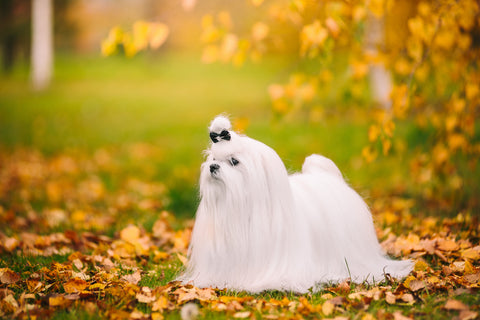 Training: Maltese dogs are known to be both sweet and fearless; in fact, the breed standard states, “He is among the gentlest mannered of all little dogs, yet he is lively and playful as well as vigorous.” This attitude can make them more willful, but they generally respond well to reward-based training. Professional obedience and crate training are recommended for every dog, especially breeds prone to anxiety like Malties. Lifestyle changes including more mentally engaging toys and healthier food can also contribute to their overall comfort and happiness.
Training: Maltese dogs are known to be both sweet and fearless; in fact, the breed standard states, “He is among the gentlest mannered of all little dogs, yet he is lively and playful as well as vigorous.” This attitude can make them more willful, but they generally respond well to reward-based training. Professional obedience and crate training are recommended for every dog, especially breeds prone to anxiety like Malties. Lifestyle changes including more mentally engaging toys and healthier food can also contribute to their overall comfort and happiness.
Exercise: These small pups have plenty of energy, but thanks to their small size, a short daily walk and some indoor play time may be all they need. Great for small homes and apartments, a Maltese can typically adjust to a new home or a small space fairly easily.
Just like most intelligent canines, Malteses require engaging toys and play time to keep their mind active. Veterinarians and veterinary behaviorists recommend snuffle rugs, treat-dispensing toys, and puzzle toys as they help dogs practice their cognitive faculties.

A Maltese dog is an outstanding companion whose outward beauty is balanced with their inner sweetness. Adding a Maltie to your home can bring so much energy, joy, and fur to your home, but the upkeep of their coat is well worth it.

